Established in 1853, Lac La Biche Mission is a Provincial Historic Resource and Parks Canada National Historic Site tucked away on the shores of its namesake lake in northeastern Alberta. Join us as we detour yet again to discover more of Alberta’s history on a mission in Lac La Biche.
Disclosure: This post contains Affiliate links.

Table of Contents
Touring Lac La Biche Mission
The wooden walkway creaks as we walk out of the visitor centre.
In the distance, gulls and other waterfowl flock over the vast waters of Lac La Biche.
Ahead, a small collection of whitewashed buildings is surrounded by a sea of green grass.
The site has two historic mission buildings: a convent and a church.
There are also several outbuildings related to the farming operations of the mission scattered across the property, including a laundry, grain shed, chicken coop, outhouse and grist mill.
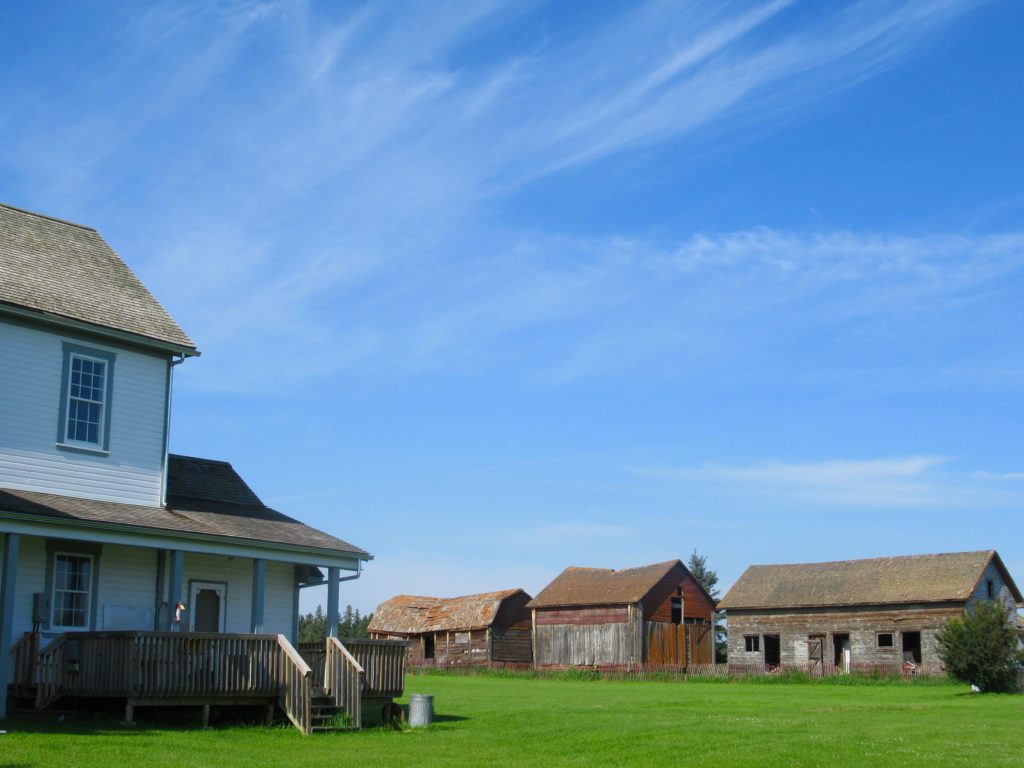
First stop on our tour – the schoolhouse.
It’s not a historic building itself, since it was only moved onto the property in 1960.
Still very much a renovation-in-progress, we climb the stairs to tour a classroom with temporary cultural displays, looking over the photos other buildings on the property undergoing renovations.
The remainder of the building is closed.
Next up, the fully restored historic convent.
The kitchen screen door slams behind us as we enter the cavernous, three story building.
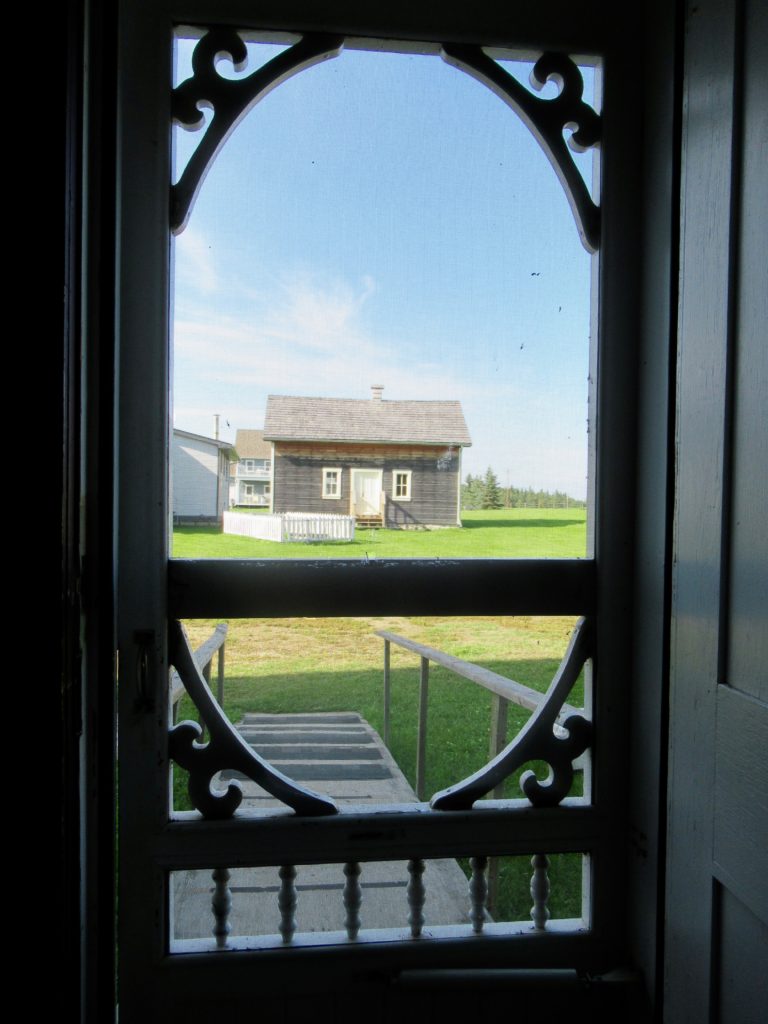
Off to the left is a small room with a table and chairs where the nuns ate when they had time.
Straight ahead is the heart of the building, with its big wood-burning stove, wide counters and cupboards to hold the food to feed hungry mouths.
Upstairs, the classroom sits empty. The dorm room beds are neatly made. The air is expectant, as if waiting for someone to come.
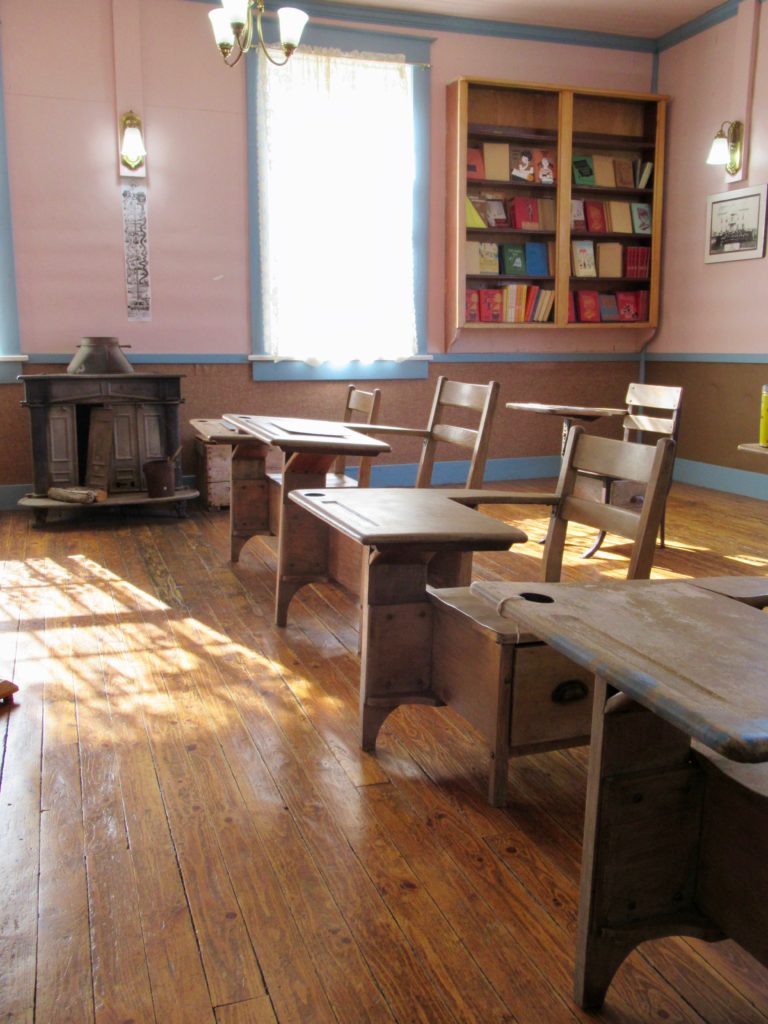
A Little Bit More of the Mission and Alberta’s History
Like the St. Charles Mission at Dunvegan, Lac La Biche’s Notre Dame des Victoires Mission was founded by Missionary Oblates of Mary Immaculate near a Hudson’s Bay Company trading post.
Unlike the Dunvegan mission, which lasted 40 years, the mission at Lac La Biche had longevity. It ran – in varying forms and under several different names – from 1853 until 1963.
The mission started out as a supply depot for missions in the Peace, Athabasca and Mackenzie River districts.
Simple log-framed buildings were built.
A road was opened from Fort Pitt to Lac La Biche, allowing supplies to be brought in by oxcart. Barley and potato crops supplemented wild game and fish.
In 1862, a colony of Grey Nuns was established at the mission.
By 1870, the mission was flourishing, serving both First Nations and Métis populations.
Did You Know? Alberta’s first printing press was brought to Lac La Biche Mission in 1877 by Reverend Émile Grouard. While in France, he had a syllabic type specially designed. Over the years Father Grouard printed books in five First Nations language, including Cree.
Changing Times
Throughout the life of the Mission, the buildings were constantly being rebuilt or renovated.
Today’s convent still contains original elements from the 1870s, such as the log beams supporting the main floor, some walls and mouldings of the roof structure.
The Sisters taught between fifteen and twenty classes each week in the convent school.
Classes included English, French, Cree, Chipewyan, theology, drawing, painting, and math.
In 1876, there were twenty-five to thirty children attending school, including both boarding and day students. Ten years later there were thirty-eight children filling the classes.
An industrial school was opened at the mission in 1885 and, in 1905, the convent building was renovated to become a boarding school.
Mention residential schools and most Canadians shudder.
A residential school is defined as a boarding school for “Indian” students. These schools were financed in part by the federal government of Canada.
Lac La Biche Mission was a little bit different.
The residential school at Notre Dame des Victoires operated for only five years, from 1893-1898. The previous 20 years of operation were not considered a residential school as the school didn’t receive official funding.
Notre Dame des Victoires was an industrial school. In addition to academics, classes included farming, gardening, sewing and knitting, cooking and housekeeping, carpentry and boat building.
In 1898, the Grey Nuns were moved to a new location. The school was closed.
Lac La Biche boarding school opened in 1905, with the arrival of another group of nuns.
This school was open to everyone, regardless of ethnicity. Students included local farm children as well as First Nations children.
The Tour Continues
Today, the Lac La Biche Mission is not affiliated in any way with the previous residential schools or the religious organizations that ran it. The mission is officially designated as both a Provincial Historic Resource and a Parks Canada National Historic Site.
Wandering through the convent/school building, we struck by the level of work one nun took to hand stencil the crown molding in the chapel.
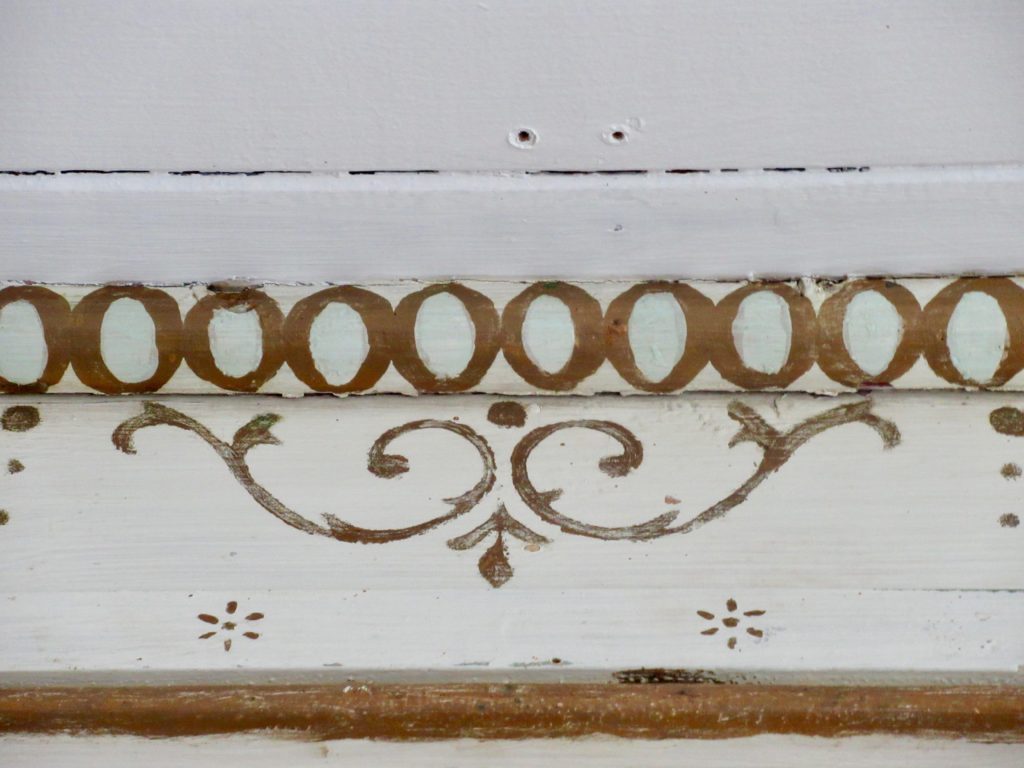
The pale blue paint in the top oval design was created by combining calcamine with robin eggshells.
Likewise, the priests’ dining room was painted green by the combination of calcamine and algae.
Heading back outside, we wandered over to the church, rebuilt in 1922-23 after a tornado destroyed the original.
Yes, a tornado!
It struck in 1921 and the church was reduced to a pile of rubble.
All that was left of the structure was the bell and the altar. Surprisingly, the altar was undamaged except for a missing hand on one of the statues and a small chip on the upper right.
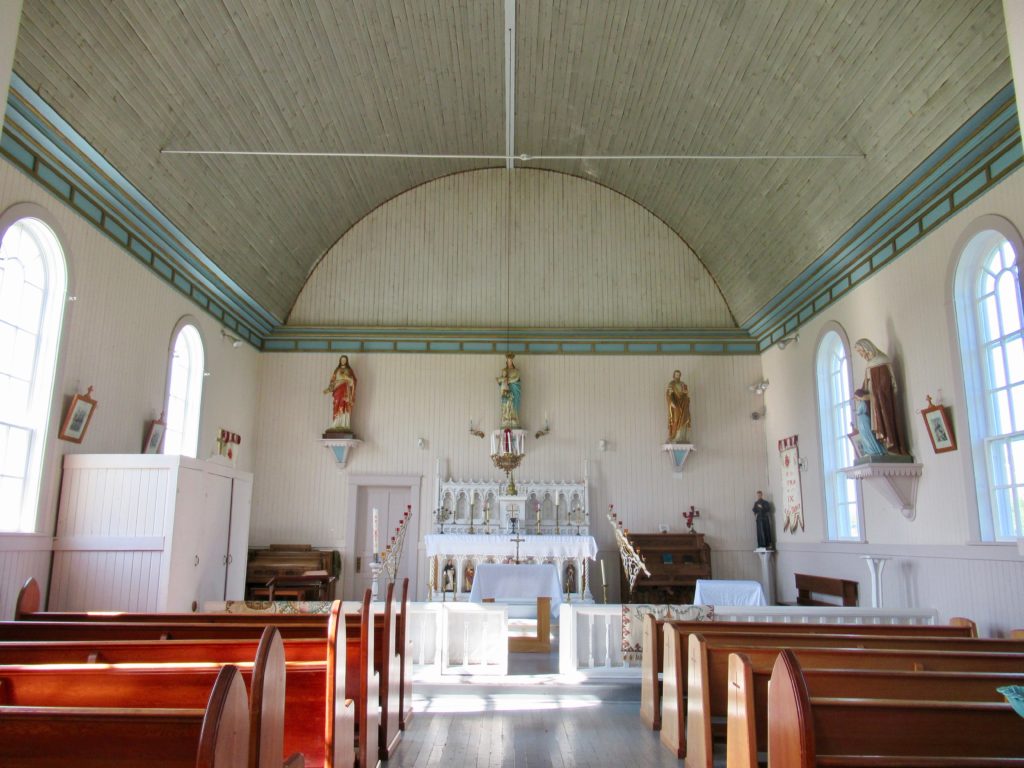
The bell went missing after the tornado…
…and then mysteriously showed up on the church steps 70 years later!
Lac La Biche Mission – visit for a snippet of Alberta’s history and a glimpse into missionary life and the mystery of the past.
Learn more about Alberta’s history in these posts:
- Discovering Alberta’s Grande Cache
- Lille Ghost Town
- Exploring Head-Smashed-In Buffalo Jump
- Exploring the Crowsnest Pass: Hillcrest Mine Disaster Memorial Park
- A Journey Close to Home: Walking Glenbow Ranch
Resources for more of Alberta’s History
Historic Sites and Museums in Alberta


“An industrial school was opened at the mission in 1885 and, in 1905, the convent building was renovated to become a residential school.”
Should read: become a boarding school.
Noted and changed; thanks Christelle.
My mother and her younger siblings attended the boarding school in approx. 1936. Are there any records, or pictures from that time?
They might. The small museum room had plenty of books and binders with lots of information and photos. I’d suggest contacting the Mission through their website and ask directly.
I struggle with this comment: “Mention residential schools and most Canadians shudder….
A residential school is defined as a boarding school for “Indian” students. These schools were financed in part by the federal government of Canada. ..Lac La Biche Mission was different. ”
I struggle because the purpose of the residential school system was the assimilate Indigenous children into a western, industrialized way of life – which sounds very similar to your ‘industrial schooling’ regardless if it was for both Canadian and Native children. If Lac La Biche Mission really was different, how did it work to preserve the language and culture of the local Cree and Metis communities, how did it protect their way of life, how did it promote their ways of knowing and learning? How did La La Biche Mission ensure that the identity and culture of the Michif and Nêhiyawêwin were preserved and celebrated in their school house?
Whether good intention or not, industrial schools, whether funded by the government of not, were tools of colonization to extinguish Native people through cultural genocide. Truth telling and accepting responsibility is the first step in reconciliation. I implore your Board of Directors to reflect on your role in Canada’s dark history in the region and update your website accordingly.
Thank you for this insightful comment, Jennifer. You have made me look at this post and how it is worded again. When I said Lac La Biche was different, I was referring to the fact that it was not just for Native children. I also believe it was a bit different than residential schools because classes included instruction in Cree and Chipewyan as well as English and French. It was never my intention to minimalize the effect these types of schools had on Native culture and communities.
With regard to your final comment, “I implore your Board of Directors to reflect on your role in Canada’s dark history in the region and update your website accordingly,” please note that I am a travel blogger and am not affiliated in any way with the mission. I travel and record my journeys and observations and invite conversations, like the one I am having with you now. I truly believe we learn from the past – even knowing that it was far from perfect – so that we can change our actions in the future.
My Mother (aged four years) and three siblings were sent to the convent at Lac La Biche when my Grandmother died. She lived there from 1920 to approximately 1930. She described life there as harsh with little food and frequent cruel treatment. In the summer she would be sent to live with local families to be a Mother’s helper looking after younger co children and helping with chores. I have only one photograph of my mother as a child and am wondering if others may exist in the archives. Whom would I contact for information or records of her life there and the lives of her siblings if such records exist.
I can only imagine what you mother’s life must have been like. If I were you, I would start by contacting the mission directly via the email at the bottom their homepage (https://laclabichemission.com/). They can point you in the right direction. Best of luck!